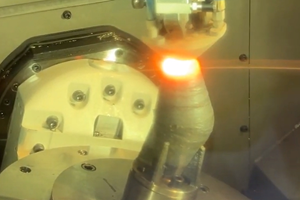Aerospace Lathe Shop Finds VMCs Enhance Commercial Work
There's no trick to reducing cycle time. It's simply a matter of knowing what tools to use for which parts.
Share






There's no trick to reducing cycle time. It's simply a matter of knowing what tools to use for which parts. Just ask Wes Scott, vice president, and Cliff Rapstine, operations manager at San Val Precision, Moorpark, California. They have managed to halve cycle time by using a VMC and rotary table from Haas Automation, in Chatsworth, California, when most shops would have used a lathe and mill.
Founded in 1954, the company had been an aerospace lathe shop until two years ago when it started adding Haas VMCs. Since then, sales and profits have doubled. The company still specializes in aerospace, but now about 30 percent of its work is commercial.
A good example of selecting the right combination of tools is the body of a transducer used to send signals from an aircraft's "black box." The body is machined out of 1 3/4-inch × 1-inch T6061 aluminum stock. The first run of 300 parts took nine minutes and 17 tool changes per part.
But that wasn't fast enough. So when a second order for 3,000 parts came in, Mr. Rapstine set up the Haas VF-0 with a Haas rotary table and a four-sided tombstone. And that was a substantial reduction in cycle time: Less than two minutes per part and 11 tool changes per load of 24 parts.
The VF-0 features 20-inch, 16-inch, 20-inch X, Y and Z travels, direct drive with a toothed drivebelt and 10-hp spindle that delivers up to 7500 rpm. Its cast-iron base helps maintain superior rigidity and dependable cutting torque.
The Haas-built, dual 32-bit processor control is Fanuc compatible with a program execution speed of 1,000 blocks per second. It features a number of Haas OneTouch features including OneTouch power-up, which turns the power on, homes all axes, picks up the number one tool and loads it into the spindle, so the machine is ready to make chips.
"The part is machined to a tolerance of ±0.002 flatness, perpendicularly, and parallelism. While the machine cuts the 24 parts unattended, the operator is free to work another machine," said Mr. Scott.
A typical transducer cycle goes like this: Six parts are loaded on each of the tombstone's four sides, and the rotary table positions the parts for each cut. Next, the transducer body was machined. First, the stock is sized and the top machined. Excess material is machined off the back and the part is positioned on end, where the soft jaw is machined, the wall drilled, and four holes are drilled and tapped. The part is then positioned on the other end and a hole drilled and tapped. The part is then positioned on its side, the clearance on the end is machined and two holes are drilled and tapped. The last step involves positioning the part on its end, and the final hole is drilled and tapped.
"Writing the program for this part was a breeze on the Haas control. It's got a good editor, with F1 and F2 functions that make it easy to cut and paste code. And the control is fast. For example, push a button and the cursor is instantly at the bottom of the program. Other controls can take quite a while scrolling through the program, from beginning to end. And G50 codes are really simple--you indicate a hole, touch a button and the offsets are loaded automatically," said Mr. Rapstine.
San Val Precision has other examples, including an aluminum volume-control knob for a high-end stereo receiver. The part used to require two lathe operations and three mill operations. It takes only three operations on the Haas VF-0 with a rotary table. The knobs are machined from 1-inch tall × 3/4-inch diameter T6061 aluminum. And the steps are simple: Machine a 1/32-inch slot, drill and tap the setscrew hole; drill, counterbore and ream the spindle hole. Profile the knob; and machine indicator line on outside of knob and finish.
"The VF-0 interpolates bores with a high degree of accuracy," said Mr. Rapstine.
San Val puts its Haas machines to good use. And they say that the machines have come through for them.
Their sales are up, and profits are up. And now, they are in the process of doubling their space from 5,000 to 11,000 square feet. MMS
Related Content
Fryer Milling Machine Provides Fast Setup, Simple Programming
The MB-R toolroom bed mill is reportedly capable of single- or multi-part production with a 0.0002" accuracy.
Read MoreAdditive/Subtractive Hybrid CNC Machine Tools Continue to Make Gains (Includes Video)
The hybrid machine tool is an idea that continues to advance. Two important developments of recent years expand the possibilities for this platform.
Read MoreIn Moldmaking, Mantle Process Addresses Lead Time and Talent Pool
A new process delivered through what looks like a standard machining center promises to streamline machining of injection mold cores and cavities and even answer the declining availability of toolmakers.
Read MoreMazak VMC Provides Versatile Machining of Complex Parts
The VC-Ez 20X vertical machining center features a 25-hp 12,000-rpm CAT-40 spindle with a 30-tool-magazine automatic tool changer.
Read MoreRead Next
AMRs Are Moving Into Manufacturing: 4 Considerations for Implementation
AMRs can provide a flexible, easy-to-use automation platform so long as manufacturers choose a suitable task and prepare their facilities.
Read MoreMachine Shop MBA
Making Chips and Modern Machine Shop are teaming up for a new podcast series called Machine Shop MBA—designed to help manufacturers measure their success against the industry’s best. Through the lens of the Top Shops benchmarking program, the series explores the KPIs that set high-performing shops apart, from machine utilization and first-pass yield to employee engagement and revenue per employee.
Read More



















